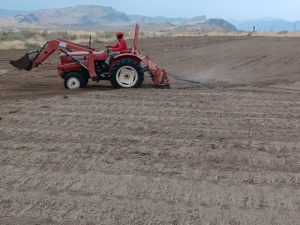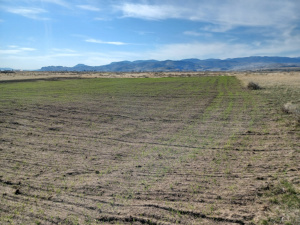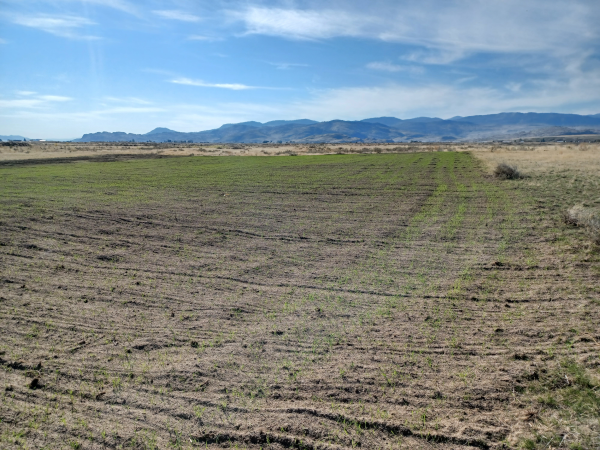Winter Wheat is planted in the fall, harvested in the spring, and can be grown without irrigation. I have not grown wheat before and it will be exciting to learn if it can produce a crop with only spring moisture. There is easily more than 10000 acres of dryland winter wheat grown less than 100 miles south of my location.
After some research I decided to plant a hard red winter wheat, LCS-Jet, that grows and produces well in this area under dryland conditions. LCS-Jet is non-GMO and all commercial wheat produced in the USA is non-GMO. Seeding rate is 75lbs per acre and a 50lb bag can cover 2/3 of an acre. I bought a 50lb bag in Almira for $20.00 and wheat seed supplier McKay Seed had the LCS-Jet sent from their Moses Lake location. The Almira location is located on a dirt road a few miles off a 2 lane highway in the middle of miles and miles of wheat fields.


Winter Wheat / Covering Seed / Sep 2023
|


Winter Wheat Sprouting / Oct 08 2023
|
Most recommendations were to add 20lbs of Nitrogen per acre in the fall and then a heavy application in the spring. Also I was planning to use Potassium Sulfate but it turned out to be much more expensive so opted for Murate of Potash which is Potassium Chloride. I bought a 130lb rotary spreader which I was able to attach to the back of the tiller tight enough so it wouldn't dump over. I had to till deeply a second time to remove the washboard ridges to get the spreader to work properly.
The Zinc was a powder and clumpy so I smashed it into smaller pieces and the spreader broke it up reasonably well. The Manganese got wet so we dissolved it in water at about 1lb per 4 gallons and sprayed it on the ground with a backpack sprayer, which took about 12-20 4 gallon tanks. Adjustment of the spreader for powder, pellets, and seed was tricky but when it pours out the bottom, adjust, pick it up, throw it back in the spreader with the dirt, and keep going.
We added the 1152 and Urea last, tilled everything in, spread the seeds, and dragged the field with the rebar harrow upside down. I actually tilled more than 2/3 of an acre so actually used 100lbs of 1152, and planted only 3/4 of the tilled area reserving the lowest area for corn next spring (part of this is visible in the right picture above at upper middle left the dark brown area).
Planting time should be September or October latest. There was 0.8 inches of raid on Sep 20th and we planted on Sep 24th 2023. I was concerned about dust but the timing was perfect. As we were finishing dragging the field it was sprinkling lightly and it rained intermittently the next few days. Now on Oct 6 2023 the wheat is sprouting in the area planted and from a distance looks like a green fuzz on the field.
Winter Wheat (Starter) Fall Fertilizer For 2/3 Acre
Note that I decided to till and fertilizer a larger area so for example it states 77lbs of KCl but I used 2 50lb bags and 2 50lb bags of 1152 then left about 0.2 acres unplanted for corn in the spring. The urea was actually about 15lbs left over from an opened bag, the 1152 also has N.
| 20 lbs Urea 46-0-0 | N 13.8 lbs/acre |
| 90 lbs 1152 11-52-0 | N 15 lbs/acre + P205 70 lbs/acre |
| 77 lbs KCl MOP 0-0-60 | K2O 70lbs/acre |
| 35 lbs FeSO4 31% Iron Monohydrate | Iron 16 lbs/acre |
| 30 lbs Zinc Sulfate 35% Zinc | Zinc 10 lbs/acre |
| 30 lbs MgO 45% Magnesium Oxide | Magnesium 20 lbs/acre |
| 12 lbs MnSO4 28% | Manganese 5 lbs/acre |
Update 2024 I did not add fertlizer in the spring and by harvest time the cheatgrass was about the same height as the wheat. The wheat did produce heads and in one are where we had spilled extra urea the wheat was taller than the cheatgrass and had larger spikes and kernels. With arid soil growing wheat is much easier than growing corn but harvest equipment for wheat is costly. We still need to find an economical and easy way to harvest and process or make use of the crop. One possibility is to raise pigeons (flying ones) and let them harvest the grain producing eggs and squabs.
Note to Self: One site states a min 80lbs K...
If K is needed, starter N+K2 O should be limited to no more than 80-100 lbs/acre in the fertilizer band to prevent salt injury. Note I am not putting fertilizer in band (for those who do not know this is putting fertilizer in the row where planting rather than broadcast which is spread evenly). Broadcasting fertilizer is less efficient especially if row spacing is wide (like corn at 4ft apart) but I don't have equipment for in-band placement.